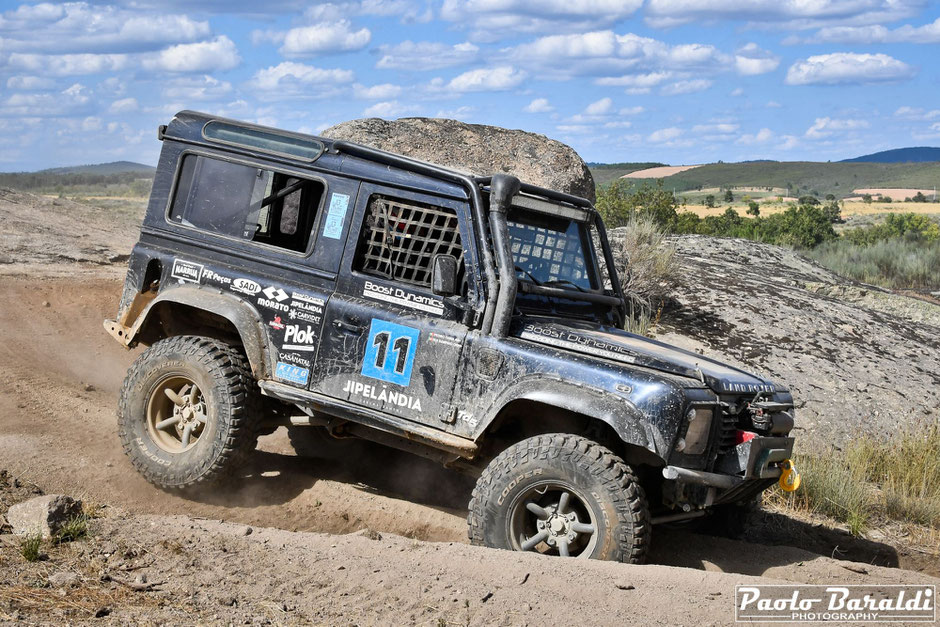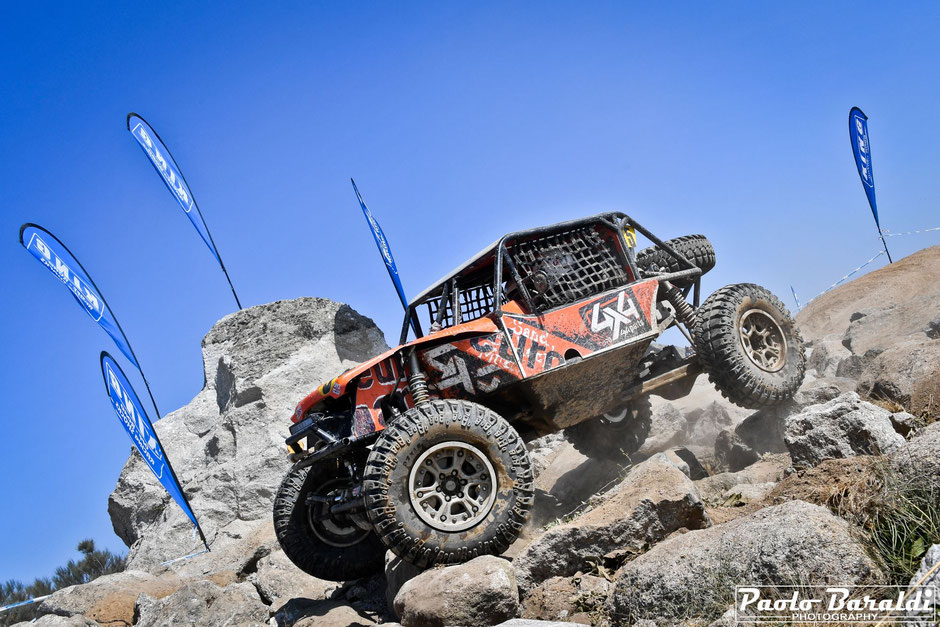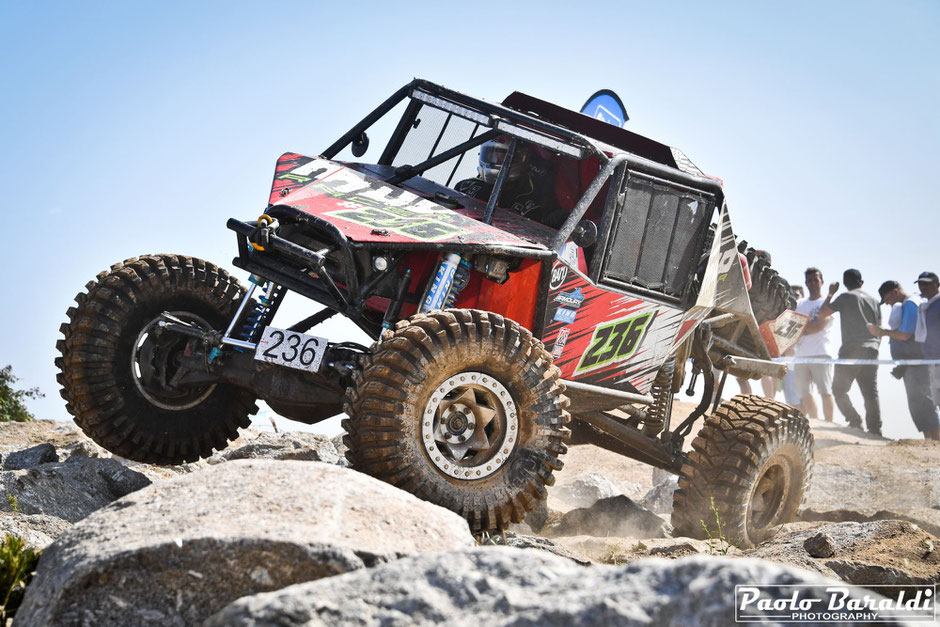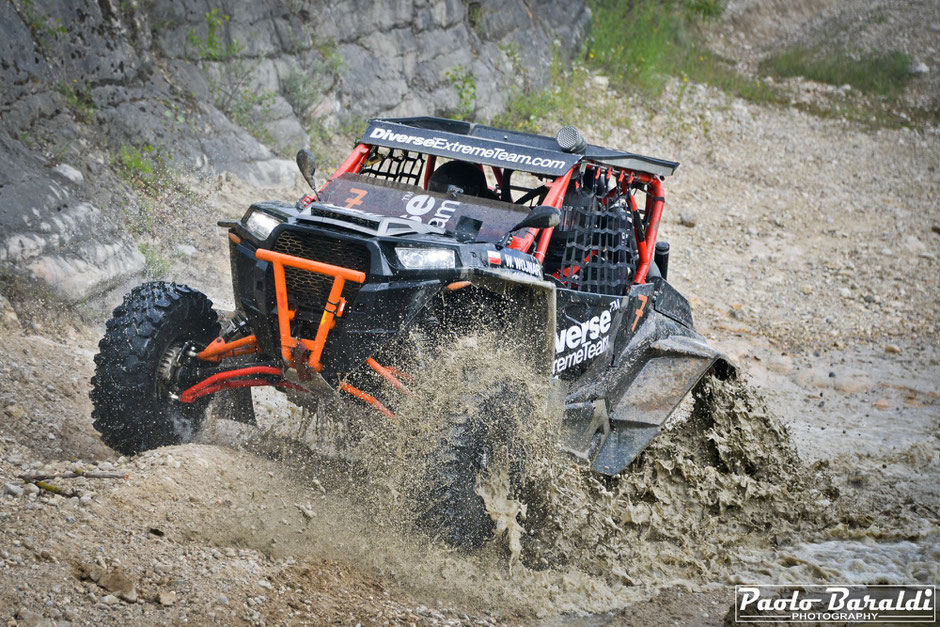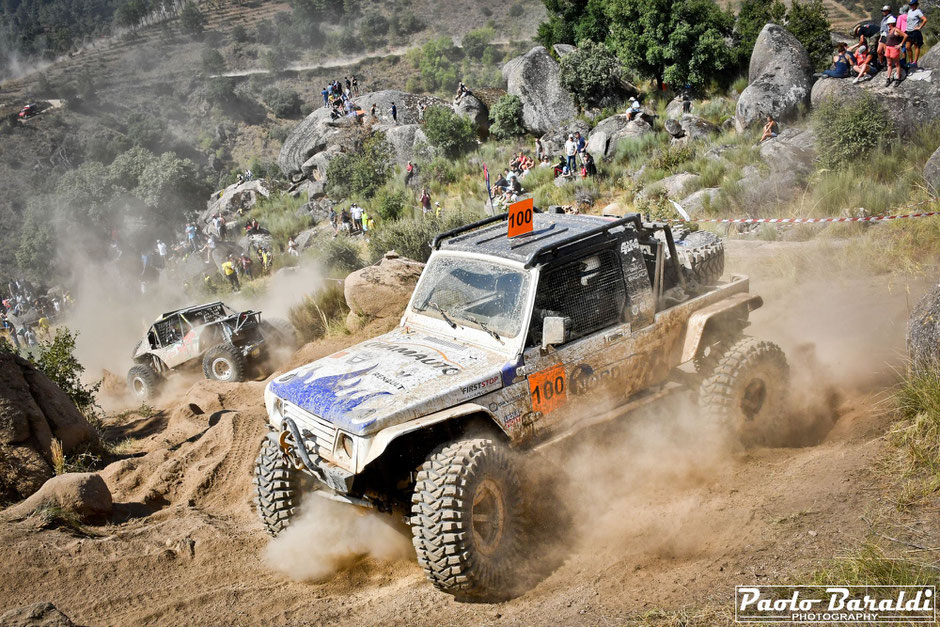With this article we go deep in the Ultra4 Europe classes of vehicles in race and how points are awarded for the championship.
Photography and story by Paolo Baraldi
Short Ultra4 history
In 2007 Dave Cole and Jeff Knoll had the idea of organizing a new competition style, totally different from those existing in the States. The King of the Hammers was born in the Johnson Valley (CA) combining the desert races and rock crawling competitions.
After the first King of the Hammers, the success and interest was so great that the Hammerking Productions were created, the public was invited to watch the race, the first sponsors appeared, the Ultra4 category was defined and the Ultra4 Racing championship started.
Ultra4 Europe, in 2012, brought this style of racing to Europe gaining great appreciation from the Ultra4 teams and fans. In just a few years, from a race they moved on to a real championship that today brings together the best European drivers.
Not just Unlimited to participate in Ultra4 Europe races
The 4400 class is the original class that started the King of Hammers race. Year after year these rigs have evolved to become increasingly powerful and performing. For their important technological development, the 4400 are considered by many people as the “Formula 1” of 4x4. Said this, it is important to know that it is possible to participate in Ultra4 Europe competitions also with other types of vehicles.
Ultra4 Europe championship
The drivers of the Ultra4 Europe championship compete not only for the victory of every single race but also to become European Champion. At the end of the year the sums of the points that everyone has acquired are made; who has more points is the champion!
With this article, we will learn more about this two aspects that are fundamental to a better understanding of the Ultra4 Europe championship: the distinction of classes and the allocation of points.
Ultra4 Europe classes
The 4x4s participating in the Ultra4 Europe championship are divided into 5 classes: Stock, Modified, Legends, Unlimited and UTV.
Ultra4 Europe classes: 4600 Stock
The spirit of the stock class is to allow OEM and aftermarket vendors the opportunity to showcase their products while providing a venue for teams to compete in a true drivers’ class in vehicles that closely relate to street driven versions of the same. The driver of record will bear the burden of proving legality of any part of their vehicle including but not limited to; Motor/Transmission, frame length, suspension configuration.
3.1 ELIGIBLE VEHICLES
3.1.1) Any and all four-wheeled, four-wheel-drive production automotive based vehicles are eligible for competition, providing they meet all the rules and regulations specified herein, and with the following limitations and exceptions: Minimum of one thousand (1000) units were produced by the original manufacturer for given model year, for given market/region. Vehicles produced for foreign markets may be imported for competition, but features and/or components found on vehicles produced for different regions/markets shall not be combined in any one vehicle if doing so would violate any rules or regulations specified herein.
3.2 FRAME & BODY
3.2.1) Stock frame (frame is considered to be the primary frame rails and all permanently factory cross members) must be retained, and must be complete and unmodified. No material may be removed for any reason and no section of the frame may be 'massaged' or re-shaped with the following limitations and exceptions: The rear portion of the frame and rear cross member may be removed or trimmed for the sole purpose installing an aftermarket rear bumper. Frames may be reinforced by adding material.
3.2.2) Stock body (body is considered to be the full cab, including all interior and exterior sheet metal, bed, doors, hood, fenders, grill, etc.) required. The body must be complete and unmodified, with the following limitations and exceptions: Holes may be cut in any part of the body for the single and exclusive purpose of allowing roll cage tubes and transmission/transfer case linkage to pass-through the body. Open holes must be kept to within .5"(12.5mm) of the diameter of any tube or linkage that passes through the body, with further restrictions related to holes in firewalls specified in Section 2.4.5. The exception to this rule is the allowance for rocker panel protection limited to the area between the wheel wells. You may cut into the body and/or reinforce this area. You may not interfere with the mating surface of the stock door and doorsill. The stock doorsill must be retained and unaltered.
3.2.3) Stock doors may be modified to create half-doors and/or may also be replaced with tubular doors. Doors must open and close, bolted on panels are not allowed.
3.2.4) Stock windows (glass) are not required, but are permitted, providing they meet DOT regulations. Alternatives to traditional safety-glass may be allowed, on approval of Hammerking Productions Inc.
3.2.5) Front inner fenders must be complete and unmodified, with the following limitations and exceptions: outer fenders (wheel well openings) may be trimmed for the single and exclusive purpose of allowing for tire clearance. Modifications to the outer fenders must preserve the look of the stock wheel wells, as originally manufactured, and must not be trimmed excessively (no more than a 2" (50mm) gap between any part of the outer fender and the tire at full compression).
3.2.6) Front outer fenders may be replaced with OEM-style aftermarket fenders (flared fiberglass fenders are permitted).
3.2.7) Rear inner and outer fenders must be complete and unmodified, with the following limitations and exceptions: outer fenders (wheel well openings) may be trimmed for the single and exclusive purpose of allowing for tire clearance. Modifications to the outer fenders must preserve the look of the stock wheel wells, as originally manufactured, and must not be trimmed excessively (no more than a 2" (50mm) gap between any part of the outer fender and the tire at full compression).
3.2.8) Extensive damage to any portion of the frame or body (prior to race start) may be considered illegal modifications, and repairs may be required, as determined by, and at the sole discretion of the Chief Technical Inspector.
3.2.9) Stock body mounts may be modified or eliminated, with the following limitations and exceptions: The relationship of the body to the frame must remain within 1" (25mm) of stock configuration, as originally manufactured. Stock body mounts shall not be modified or eliminated for any reason other than to allow any part of the roll cage to pass through the body in order to be securely attached to the chassis.
3.2.10) Factory headlights are required and must be functional.
3.2.11) Factory bumpers are not required and may be modified or eliminated.
3.3 ENGINE
3.3.1) Stock engine must be retained, but may be replaced with any available in make/model/year. Any and all modifications are permitted, with the following limitations and exceptions: Stock engine-block must be retained, as originally manufactured (boring, stroking and other internal engine modifications are all permitted). Forced-induction of all types is not permitted, unless factory-equipped.
3.3.2) If equipped with a water-cooled engine, the radiator must remain within 6" (150mm) of the original location, as originally manufactured
3.4 TRANSMISSION
3.4.1) Stock transmission must be retained, but may be replaced with any available in make/model/year. Any and all modifications are permitted, with the following limitations and exceptions: Stock transmission case/s must be retained, as originally manufactured. Auxiliary transmissions (e. g. secondary transmissions, under / over- drives, etc.) are not permitted.
3.5 TRANSFER-CASE
3.5.1) Any and all transfer-cases are permitted, providing they meet all the additional rules and regulations specified herein.
3.6 DRIVESHAFTS
3.6.1) Any and all driveshafts are permitted, providing they meet all the additional rules and regulations specified herein.
3.7 AXLES
3.7.1) Any and all axle assemblies are permitted, providing they meet all the additional rules and regulations specified herein.
3.8 STEERING
3.8.1) Steering components may be modified or eliminated and steering components/linkage may be installed in any location and orientation, with the following limitations and exceptions: All vehicles must retain some type of mechanical steering linkage (e. g. 'full-hydro' steering is not permitted, unless factory-equipped), and said linkage must be capable of controlling the direction of the steering wheels/tires without the benefit of any additional power-steering aids. The steering box (or rack, if so-equipped) must remain within 4" (100mm) of the stock location. No part of the steering linkage shall be oriented so as to be partially or substantially parallel to the frame rails or any part of the suspension linkage, with the exception of the drag-link and track-bar (if so-equipped, and unless otherwise- equipped, as originally manufactured). Rear-steer is not permitted.
3.9 SUSPENSION
3.9.1) Wheelbase must remain within 3" (75mm) of stock, as originally manufactured.
3.9.2) Suspension configuration must remain stock, as originally manufactured (meaning that leaf springs must remain leaf springs, coil springs must remain as coil springs, torsion-bars must remain as torsion-bars, etc.).
3.9.3) Leaf springs may be replaced with any leaf springs and may be installed in any location and orientation, with the following limitations and exceptions: Leaf springs must be connected directly to the axle assembly, unless otherwise factory-equipped. Links/linkage may be installed, but the leaf springs must be capable of locating the axle assembly relative to the chassis in any direction without the use of any such links/linkage. As such, quarterelliptical springs, transverse leaf springs, and the use of double-shackles (at the forward and rear leaf spring mounting points at the chassis) are not permitted, unless factory-equipped.
3.9.4) Coil-springs and related suspension linkage may be modified or eliminated and replaced with any coil-springs and linkage, and may be installed in any location and orientation, with the following limitations and exceptions: Coilsprings must be connected directly to the axle assembly and chassis and shall not be mounted in any way so as to yield any type of mechanical advantage, unless factory-equipped. Coil- springs shall not be replaced with any type of coil-over shocks, unless factory- equipped (if so-equipped, factory coil-over shocks may be replaced with aftermarket coil-over shocks).
3.9.5) Secondary suspension is not permitted, unless factory-equipped (secondary suspension is considered to be any means or method of supporting any portion of a vehicle's weight and/or affecting the primary spring-rate at any time). As such, springs of all types and airbags, are not permitted.
3.9.6) Air/nitrogen-charged hydraulic bump stops, compressible bump stops made of rubber, foam, or other similar materials are permitted, with the following limitations and exceptions: Bump stops shall not have any action whatsoever on any aspect of a vehicle's performance outside of the last 2" (50mm) of vertical wheel-travel (on compression).
3.9.7) Shock absorbers of any make/model/type are permitted and may be installed in any location and orientation, with the following limitations and exceptions:
1) Only one shock absorber is permitted per wheel/tire (not including spare tires). Shock absorbers shall not be larger than 2.65" (67mm) in diameter (outer diameter of shock-body) and shall not be capable of any more than 14" (355.6mm) stroke.
2) Position-sensitive shocks (including bypass shocks of all types) are not permitted.
3) Shock absorbers must be connected directly to the axle assembly and chassis and shall not be mounted in any way so as to yield any type of mechanical advantage, unless factory-equipped (mounting shock absorbers off-vertical is permitted and shall not be considered a mechanical advantage).
3.9.8) Manual suspension controls (e.g. forced hydraulics) are not permitted.
3.10 WHEELS & TIRES
3.10.1) The intent of the tire rule for the stock class is to restrict tire use to only standard production models designed, sold, and advertised for use on highway vehicles. Therefore all tires used in competition shall be readily available to the public from any local distributor. Tires with special construction, compounds, etc. created for the sole purpose of competition will not be allowed.
3.10.2) Tires must be DOT-approved, with a maximum outside diameter of 35" (or equivalent), as specified on the tire’s sidewall by the original manufacturer, unless otherwise stated in supplementary regulations covering special events (e.g. Colorado hill climb events).
Ultra4 Europe classes: 4500 Modified
4.1 FRAME & BODY
4.1.1) The frame is considered to be the primary frame rails used to mount the drive train and body. It shall run from the OEM motor mount location to behind the rearmost portion of the occupants' seats. The balance of the frame shall remain whole however allowances will be made for suspension mounting.
4.1.2) The stock frame should be retained, however aftermarket and custom frames are allowed. Aftermarket and custom frames must be of a boxed design with minimum dimensions of 1.5” (38mm) x 3” (75mm) x 0.120” (3.0mm).
4.1.3) At static ride height the bottom of the frame rails shall be no higher than the top of the tire.
4.1.4) At no point shall the frame rails be closer than 16” (406mm), measured horizontally.
4.1.5) The frame rails must remain within 4” (100mm) of vertical alignment in relation to each other for the entire length of the frame.
4.1.6) The body is considered to be the exterior of the cab, bed, doors, hood, front/rear fenders, grill, etc.
4.1.7) All vehicles shall resemble an OEM production vehicle, and the body shall be complete with the following limitations and exceptions: Modifications to the body for performance and/or clearance are permitted but must preserve the look of the stock body, as originally manufactured.
4.1.8) For the purpose of the Modified Class a Production Vehicle is defined as any vehicle that has a minimum of 250 chassis/body combinations sold to the public.
4.2 ENGINE
4.2.1) Any and all engines are permitted, providing they meet all the additional rules and regulations specified herein, and with the following limitations and exceptions: The back of the engine-block must be located in front of the furthest-forward portion of the driver's seat, unless otherwise-equipped, as originally manufactured in a 4WD configuration.
4.2.2) Radiator mounting open.
4.3 TRANSMISSION
4.3.1) Any and all transmissions are permitted, providing they meet all the additional rules and regulations specified herein.
4.4 TRANSFER-CASE
4.4.1) Any and all transfer-cases are permitted, providing they meet all the additional rules and regulations specified herein.
4.5 DRIVESHAFTS
4.5.1) Any and all driveshafts are permitted, providing they meet all the additional rules and regulations specified herein.
4.6 AXLES
4.6.1) Any and all axle assemblies are permitted, providing they meet all the additional rules and regulations specified herein.
4.7 STEERING
4.7.1) All vehicles must retain some type of mechanical steering linkage (e. g. 'fullhydro' steering is not permitted, unless factory-equipped matching frame), and said linkage must be capable of controlling the direction of the steering wheels/tires without the benefit of any additional power-steering aids. Rearsteer is not permitted.
4.8 SUSPENSION
4.8.1) Any and all suspension components and configurations are permitted, providing they meet all the additional rules and regulations specified herein.
4.8.2) Shock absorbers of any make/model/type are permitted and may be installed in any location and orientation, with the following limitations and exceptions:
1) Only two shock absorbers are permitted per wheel/tire (not including spare tires).
2) Shock absorbers shall not be larger than 2.65" (67mm) in diameter (outer diameter of shock-body) and shall not be capable of any more than 14" (355.6mm) stroke.
3) Shock absorbers must be connected directly to the axle assembly and chassis and shall not be mounted in any way so as to yield any type of mechanical advantage, unless factory-equipped (mounting shock absorbers off-vertical is permitted and shall not be considered a mechanical advantage), or equipped with any type of independent suspension (and then shock absorbers may only be mounted to as to yield a mechanical advantage at the wheels/tires that are independently suspended).
4.8.3) Manual suspension controls (e.g. forced hydraulics) are not permitted.
4.8.4) Independent Suspensions are not allowed in the Modified class with the following exception:
1) Independent Suspended vehicles must use OEM Factory Frame and OEM Factory Body Style for that make/model year and the vehicle must have been Independent for that make/model year.
2) Frame requirements will exceed class rules to include suspension mounting points for the independent portion of the suspension.
4.9 WHEELS & TIRES
4.9.1) The intent of the tire rule for the modified class is to restrict tire use to only standard production models designed, sold, and advertised for use on highway vehicles. Therefore all tires used in competition shall be readily available to the public from any local distributor. Tires with special construction, compounds, etc. created for the sole purpose of competition will not be allowed.
4.9.2) Tires must be DOT-approved, with a maximum outside diameter of 37" (or equivalent), as specified on the tire’s sidewall by the original manufacturer.
Ultra4 Europe classes: 4800 Legends
5.1 ENGINE
5.1.1) Engine must be front mounted.
5.2 SEATS
5.2.1) 2 seats must be side by side.
5.3 SUSPENSION
5.3.1) Shocks: only a single shock per corner is allowed. Any coil carrier apparatus are considered shocks.
5.4 AXLES
5.4.1) Axles must be solid type. No TTB or IFS of any kind allowed.
5.5 TIRES
5.5.1) Tires must be DOT NON STICKY compound no larger than 37” Diameter as factory labeled.
5.6 SAFETY
5.6.1) All safety and tech rules apply.
Ultra4 Europe classes: 4400 Unlimited
6.1 ENGINE
6.1.1) Any and all engines are permitted, providing they meet all the additional rules and regulations specified herein.
6.2 TRANSFER-CASE
6.2.1) Any and all transfer-cases are permitted, providing they meet all the additional rules and regulations specified herein.
6.3 DRIVESHAFTS
6.3.1) Any and all driveshafts are permitted, providing they meet all the additional rules and regulations specified herein.
6.4 AXLES
6.4.1) Any and all axle assemblies are permitted, providing they meet all the additional rules and regulations specified herein.
6.5 STEERING
6.5.1) Any and all steering components and configurations are permitted, providing they meet all the additional rules and regulations specified herein. Rear steering is permitted.
6.6 SUSPENSION
6.6.1) Any and all suspension components and configurations are permitted, providing they meet all the additional rules and regulations specified herein.
6.6.2) Shock absorbers of any make/model/type are permitted and may be installed in any location and orientation, providing they meet all the additional rules and regulations specified herein.
6.6.3) Manual suspension controls (e.g. forced hydraulics) are permitted.
6.7 WHEELS & TIRES
6.7.1) Any and all tires are permitted, providing they meet all the additional rules and regulations specified herein.
Ultra4 Europe classes: 4900 UTV
7.1 DEFINITION
7.1.1) A UTV is defined as a standard production based side by side style vehicle, single seats included. 1000 CC or less motor with powersports based drivetrain. Any non-production based belt driven vehicles must be approved prior to racing.
7.2 SAFETY
7.2.1) UTV Safety – UTV’s to follow all Ultra4 Safety rules with the following exceptions.
7.2.2) Six Point cage is required. Cage must be directly connected to the sub chassis at all six points.
7.2.3) Safety harnesses meeting 2.2.8 are required.
7.2.4) Seats must have slots for harnesses and adequate headrest contact with a helmet on. Seats intended for racing are highly recommended.
7.2.5) If doors do open, a mechanical secondary latch is required. (zip ties, velcro, tape, do not count as mechanical).
7.2.6) Window nets meeting section 2.2.9 are required. Arm restraints may be used in addition to window nets.
7.2.7) Factory plastic fuel cells allowed if used in factory mounting position.
7.2.8) All seats must be attached completely by metal components. NO plastic components are allowed, even if as originally supplied by manufacturer. The factory latch may be retained.
7.3 PERFORMANCE
7.3.1) Engines must be of 1000cc or less powersports configuration. Overboring of motor is permitted.
Ultra4 Europe campionship points
Points are assigned as follows for each race in the ULTRA4 Series.
1000 points for winning, 975 points for 2nd, and 965 for 3rd.
For every driver from 4th place through the last driver that completes 2/3 of the race (determined by miles or laps depending on race format), each driver will receive 5 less points than the driver who finished ahead of them. Example: 4th is 960, 5th is 955, 6th is 950 through the last driver to complete 2/3 of the race. The 2/3 mark will be announced on site at drivers meeting prior to race.
Every driver that starts the race receives 200 points for starting. For each driver that starts, but does not complete 2/3 of the race, the points remaining between the last 2/3 finisher and the 200 points for starting will be divided based on the number of miles/laps/checkpoints necessary for 2/3 then multiplied by the number of laps/miles/checkpoints completed by the driver. Miles, laps or checkpoints will be determined based on race format. Example: If 10 drivers finish the necessary 2/3 of the course. The last driver to be assigned the 5 point increment will be the 10th place driver awarded 930 points. The remaining drivers will have 730 points (930-200) divided by the number of miles/laps/checkpoints necessary for 2/3. Using the 2017 Smittybilt Every Man Challenge race as an example Pit 2A at 94 miles was the 2/3 point. 730/94 = 7.76. A driver that completed 1 mile will receive 208 (200+(7.76*1)) points. A driver that completed 89 miles will receive 891 points (200+(7.76*89)).
Should less than 10 drivers not complete 2/3 of the race, the top 10 drivers for each race will be assigned points based on the 5 point reduction scale, and all points after 10th place (930 points) will be assigned per the formula above.
7 bonus points are awarded to the driver who qualifies the fastest in their class at each race.
At short course events, where qualifying and heat races are held, heat race winners starting positions for the main race will be based on their initial qualifying position, not the overall speed of respective heat races. This is only for the main race, not B Mains or LCQs.
Per the rulebook, a driver must compete in all respective races to be eligible for the championship. Driver of record may appoint one substitute driver to race in one regional race in lieu of the driver and have it count towards the driver of record points.


















